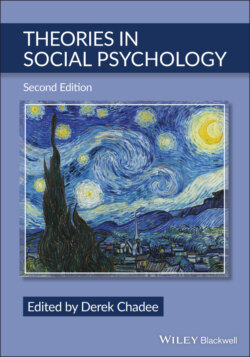Читать книгу Theories in Social Psychology - Группа авторов - Страница 16
Social Interaction
ОглавлениеAndreoli, Worchel, and Folger’s (1974) research examines arousal by implication (i.e., observing another’s freedom being threatened – indirect) and not only by the presence or intended presence of a future threatener. Earlier work by Sensenig and Brehm (1968) found that the magnitude of reactance was increased for persons who expected future interaction with a previously direct threatener. The 1974 study asked persons to give a ranking of five desired topics for discussion. Respondents were randomly assigned to one of three conditions and then placed in a room and, while waiting, heard a discussion in which a person’s (B) freedom-of-topic choice was threatened by another person (A) (threat condition).
The respondent’s first-ranked topic choice was chosen by A without consultation with B. The threatened and restored condition by the experimenter (restored condition) involved the respondent’s first-ranked topic choice being chosen by A without consultation with B, but the experimenter intervened to ensure B’s participation in the topic selection. The third condition was a non-threat (neutral condition), where there was a preference for the respondent’s first topic choice, but consultation with B was implied. Following exposure, respondents rated the five topics.
The major findings of the study suggest that indirect threats to the freedom of others (i.e., indirect threats to the observer) provoked reactance in the observer as though they were direct threats and despite whether there would be future interaction with the threatener. As a result of the threat to their freedom to choose their first-ranked topic in the threat condition, subjects were more desirous of their second and third-ranked topics than the first. The study also found that reactance emerging from implication can be restored by implication, as in the restored condition with the experimental intervention. Unlike previous studies (Worchel, 1974; Worchel & Andreoli, 1974), derogation of the threatener was absent, with no significant difference in the attractiveness rating of the threatener among the three conditions. In the previous studies, there were direct interactions with the threatener. However, in this study there is an indirect interaction. Baer et al.’s (1980) study assesses the extent to which the expression of autonomy moderated by self-presentation can reduce psychological reactance. Though their research tested a similar hypothesis to Brehm and Mann (1975) study, which did not find differences in psychological reactance in public and private expressions of autonomy, they used a different experimental design than the 1975 study. They randomly assigned respondents to each of the experimental conditions to ensure that they were not primed in the public or private attitude conditions. The study utilized a 3 (prior exercise of freedom: public exercise, private exercise, no exercise) × 2 (threat: mild or severe) × 2 (manner of postcommunication attitude disclosure: public or private) factorial design. The study hypothesized that the prior exercise of public expression of freedom condition would more likely reduce reactance than private and nonprior conditions since it acted as a mechanism for the projecting of autonomy. The study also found that postcommunication attitude change occurred in the opposite direction to the threatening communication, and only in the projection of autonomy condition, that is the public postcommunication condition.
The findings of Baer et al. (1980) suggest that private attitudes, although maintaining autonomy, do not allow for the projection of autonomy and are unable to reduce psychological reactance. The major findings of the study support the self-presentation model of projected autonomy in the reduction of psychological reactance. This held true whether the expression of the autonomy was prior or subsequent to the threat. The inability of projecting autonomy motivated people to engage in postcommunication reactance attenuation.
Social exchange theory suggests that norms of reciprocity underlie social interaction, and people are motivated to return rewards and favors of others (Homans, 1974). Counter to the social exchange proposition on norms of reciprocity, Brehm and Cole (1966) argue that favors and rewards may provoke non-reciprocation. They posit that the favored person will experience reactance because there is a pressure, as a result of the norms of reciprocity (see Gouldner, 1960), to return the favor which is interpreted as a threat to one’s freedom. The intensity of reactance actually experienced will result from the degree to which one will want to be freed from the pressures of reciprocation, that is returning the favor. The authors (p. 420) note:
If a person thought he was free to engage in Behaviors X, Y, and Z, and Behavior X were then somehow made impossible, he would experience reactance and would be motivated to recover his freedom to engage in X. Conversely, if he were “forced” to engage in X, his consequent reactance would lead him to avoid X and attempt Y or Z.
The reactance reduction strategy may involve the elimination of any sense of obligation toward the favorer and show little or no gratitude to the favorer. Reactance theory also questions the hypothesis on the inverse relationship between group attractiveness and disagreement with others in groups – that is, as group attractiveness increases, group disagreement within the group decreases. Brehm and Mann’s (1975) study hypothesizes that threats to freedoms of low importance encourage a direct relationship between group attractiveness and movement toward the group position. However, there is an inverse relationship between group attractiveness and gravitation to group position in conditions of high importance of freedom. The findings showed that a boomerang effect (i.e., reactance resistance) occurred privately and pushed behaviors toward public display of this effect in the high importance of freedom condition with pressure for conformity.
However, modifications of this condition (high importance of freedom condition with pressure for change), with the removal of the pressure but keeping the high importance of freedom, created a sleeper effect (i.e., change occurring but not immediately), with private opinion modifying in a positive direction toward the group.
